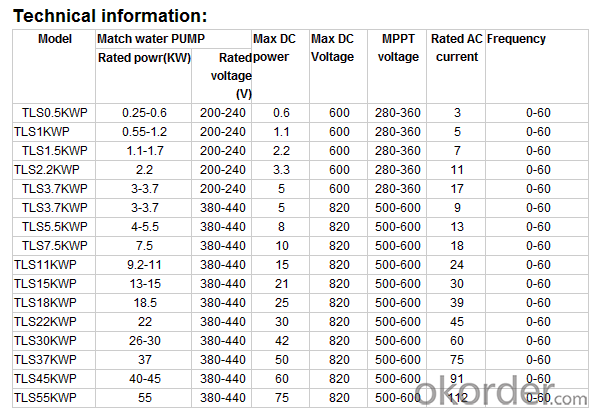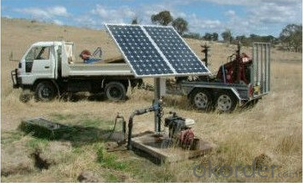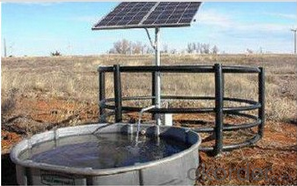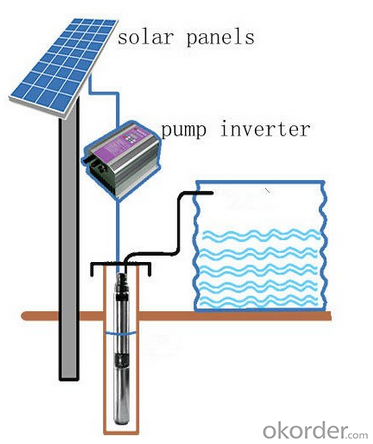solar pump inverter CE LCD display with MPPT function three(3)phase AC (0.5KW-55KW)
- Loading Port:
- China main port
- Payment Terms:
- TT OR LC
- Min Order Qty:
- 1 unit
- Supply Capability:
- 20000 unit/month
OKorder Service Pledge
OKorder Financial Service
You Might Also Like
Specifications
On grid solar pump inverter (0.5KW-55KW)
10 years expert in solar products
Competive price with good quality
Product Description:
Solar water pumping system is constructed with solar panel array,solar pump inverter and AC water pump, DC current produced from solar panel,then delivered to solar pump inverter,and it will convert it into AC current to drive water pump,and will automatically regulate output frequency according to sun radiance intensity,maximally realize MPPT tracking function.
Product Features:
1. Adopting the proposed dynamic VI maximum power point tracking (MPPT) control method, with fast response, and reliable operation, achieves efficiency of 99%.
2.Designed with variable frequency driver, greatly improves efficiency.
3.Extremely high efficiency.
4.Digital mode control, with automatic operation and manual operation mode options.
5.Complete protection functions.
6.Adopts intelligent IPM module, with high reliability.
7.LCD display and operation panel, in real time presents operating data.
8.Optional for water level measurement and control circuit.
9.Applicable for general ACC pumps, like centrifugal pump, piston pump etc.
10.Independent intellectual property; Highly effective, the redundant reliability, exempts the maintenance and the long life.
11.The pumps are soft started, fully protected.
12.No batteries are used. So better Sunlight, more water.




- Q:Can a solar inverter be used with a solar-powered lighting system?
- Yes, a solar inverter can be used with a solar-powered lighting system. The solar inverter is responsible for converting the direct current (DC) generated by the solar panels into alternating current (AC) that can be used to power the lighting system. It ensures efficient energy conversion and ensures compatibility between the solar panels and lighting system.
- Q:What maintenance is required for a solar inverter?
- Regular maintenance is required for a solar inverter to ensure its optimal performance. This includes cleaning the inverter and its components to remove any dust or debris, inspecting and tightening electrical connections, checking and replacing any faulty or worn-out parts, monitoring the inverter's performance and efficiency, and keeping track of any software updates or firmware upgrades provided by the manufacturer. It is also important to regularly clean and maintain the solar panels and other associated equipment to ensure the inverter's functionality.
- Q:How does a solar inverter handle voltage dips or fluctuations in the grid?
- A solar inverter handles voltage dips or fluctuations in the grid by constantly monitoring the grid voltage. When it detects a dip or fluctuation, it rapidly adjusts its output voltage to stabilize the grid voltage. This process is known as grid support or grid-tied operation and ensures that the solar inverter maintains a steady and synchronized connection with the grid, even during voltage disturbances.
- Q:Can a solar inverter be used in systems with different module orientations?
- Yes, a solar inverter can be used in systems with different module orientations. Solar inverters are designed to convert the direct current (DC) generated by the solar panels into alternating current (AC) that can be used to power electrical devices. They are compatible with various module orientations, including both portrait and landscape orientations. However, it is important to consider the efficiency and performance of the solar system when installing modules with different orientations, as it may affect the overall energy production.
- Q:Can a solar inverter be used in areas with high levels of electrical noise or interference?
- Yes, a solar inverter can be used in areas with high levels of electrical noise or interference. However, it is important to ensure that the solar inverter is designed and equipped to handle such conditions. Some modern solar inverters have built-in features and technologies that help mitigate electrical noise and interference. These features may include advanced filtering, shielding, and surge protection mechanisms. Additionally, proper grounding and installation practices can also help reduce the impact of electrical noise and interference on the performance of the solar inverter. It is advisable to consult with a professional or the manufacturer of the solar inverter to ensure compatibility and optimal performance in high-noise environments.
- Q:What is the importance of voltage and frequency control in a solar inverter?
- The importance of voltage and frequency control in a solar inverter is paramount as it ensures the efficient and reliable operation of the solar power system. Voltage control helps maintain the appropriate voltage levels, enabling the safe and optimal utilization of the generated solar energy. It ensures compatibility with the electrical grid and protects connected appliances and devices from potential damage. Similarly, frequency control ensures that the output power from the solar inverter matches the frequency of the grid, enabling seamless integration and preventing disruptions in the electrical supply. Both voltage and frequency control play a crucial role in maximizing the performance and stability of the solar inverter system.
- Q:How does a solar inverter handle grid frequency deviations?
- A solar inverter handles grid frequency deviations by constantly monitoring the grid frequency. When the grid frequency deviates from the standard range, the inverter adjusts its output frequency accordingly to match the grid frequency. This allows the inverter to maintain synchronization with the grid and continue injecting power efficiently, ensuring stability and reliability of the solar power system.
- Q:What is the role of a solar inverter in a microgrid system?
- The role of a solar inverter in a microgrid system is to convert the direct current (DC) electricity generated by solar panels into alternating current (AC) electricity that can be used to power various appliances and devices within the microgrid. Additionally, the solar inverter helps manage the flow of electricity between the microgrid and the main utility grid, allowing for efficient energy distribution and grid stability.
- Q:How does a solar inverter handle temperature variations?
- A solar inverter is designed to handle temperature variations by incorporating advanced thermal management systems. These systems ensure that the inverter operates within a specified temperature range, typically between -25 to 60 degrees Celsius. The inverter uses internal fans, heat sinks, and sometimes liquid cooling mechanisms to dissipate heat generated during operation. Additionally, the inverter may have temperature sensors that monitor the internal and external temperatures, allowing it to adjust its performance and efficiency accordingly. This temperature management enables the solar inverter to operate optimally and maintain its reliability even in extreme temperature conditions.
- Q:How does a solar inverter handle voltage flicker?
- A solar inverter handles voltage flicker by continuously monitoring the voltage fluctuations in the grid and adjusting its output accordingly. It uses advanced control algorithms to stabilize the voltage and maintain a consistent power supply to the connected devices. Additionally, it may have built-in features such as reactive power compensation and voltage regulation to minimize voltage flicker and ensure a smooth and reliable energy conversion process.
1. Manufacturer Overview |
|
|---|---|
| Location | |
| Year Established | |
| Annual Output Value | |
| Main Markets | |
| Company Certifications | |
2. Manufacturer Certificates |
|
|---|---|
| a) Certification Name | |
| Range | |
| Reference | |
| Validity Period | |
3. Manufacturer Capability |
|
|---|---|
| a)Trade Capacity | |
| Nearest Port | |
| Export Percentage | |
| No.of Employees in Trade Department | |
| Language Spoken: | |
| b)Factory Information | |
| Factory Size: | |
| No. of Production Lines | |
| Contract Manufacturing | |
| Product Price Range | |
Send your message to us
solar pump inverter CE LCD display with MPPT function three(3)phase AC (0.5KW-55KW)
- Loading Port:
- China main port
- Payment Terms:
- TT OR LC
- Min Order Qty:
- 1 unit
- Supply Capability:
- 20000 unit/month
OKorder Service Pledge
OKorder Financial Service
Similar products
New products
Hot products
Hot Searches
Related keywords






























